The private label food solution implementation uses six alternate classifications. Each is described in the subsequent sections.
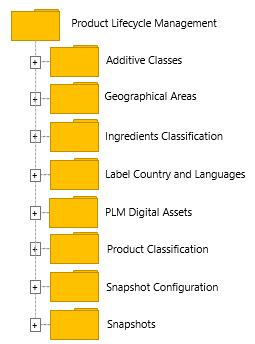
|
Object Type Name |
Object Type ID |
Purpose |
|---|---|---|
|
Product Lifecycle Management |
ProductLifecycleManagementClassifRoot |
The root node of the Product Lifecycle Products. |
Additive Classes
Organizes additives into one or more classes, based on classifications of GSFA (General Standard for Food Additives), an international standard administered by the Codex Alimentarius Commission.
For example, the same additive can be used as an acidifier or a color retention agent. On product labels, the purpose of the additive must be declared along with the additive.
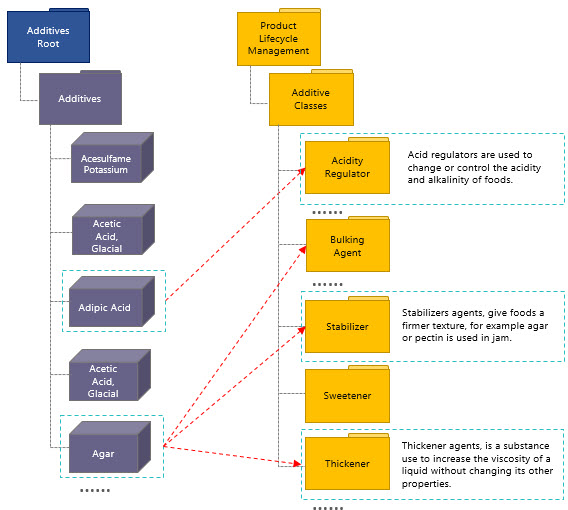
|
Object Type Name |
Object Type ID |
Purpose |
|---|---|---|
|
Additive Class Root |
PLMAdditiveClassRoot |
A top-level organization level for additive classes. |
|
Additive Class |
PLMAdditiveClass |
Organizes additives into one or more classes, based on classifications of GSFA (General Standard for Food Additives), an international standard administrated by the Codex Alimentarius Commission. An additive is classified according to the purpose function. For example, the same additive can be used as an acidifier or a color retention agent. On a product label, the purpose of the additive must be declared along with the additive. |
Geographical Areas
Organization for geographic areas of the world where the customer may sell their products. It includes regions and countries.
Countries classification is used to relate projects to countries where the product is intended to be sold. Also used to relate requirements and parameters so specific values of a basic requirement or parameter can be tailored for the country where it will be sold. The requirement or parameters can vary based on regulations or standards for that country.
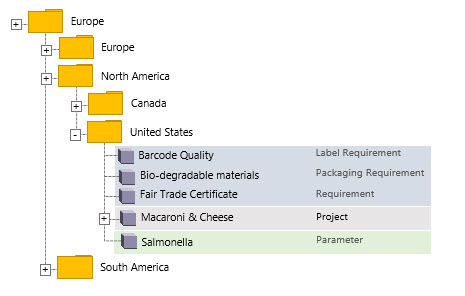
|
Object Type Name |
Object Type ID |
Purpose |
|---|---|---|
|
Geographical Areas Root |
PLMGeographicalAreasRoot |
A top-level organization level for geographic areas of the world where the customer may sell their products. |
|
Country |
PLMCountry |
A classification for countries. This classification is used to relate Design Specifications to countries where the product is intended to be sold. Also used to relate requirements and parameters to countries so that the requirement or parameters can vary based on regulations or standards for that country. |
|
Region |
PLMRegion |
An organization level for countries. (optional) |
Ingredients Classification
Ingredients classifications organize ingredients in groups based on their allowable purpose, like whether food is intended for animals or humans. This allows ingredient searches used in the Web UI to specify ingredient component result in only relevant ingredients. It categorizes ingredients into relevant groupings for maintenance purposes and for specifying a group of ingredients that may be allowable.
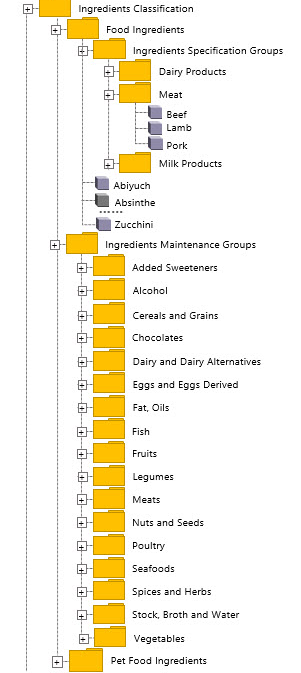
|
Object Type Name |
Object Type ID |
Purpose |
|---|---|---|
|
Ingredients Classification Root |
PLMIngredientsClassificationRoot |
Classification for ingredients; supports finding different ingredients under Food or Pet Food. |
|
Ingredient Maintenance Groups |
PLMIngredientMaintenanceGroups |
Categorizes ingredients into relevant groupings for maintenance. |
|
Ingredient Purpose |
PLMIngredientPurpose |
Organizes groups of ingredients by their allowable purpose, e.g., Food versus Pet Food so that ingredient searches result in only relevant ingredients. |
|
Ingredient Group |
PLMIngredientGroup |
Categorizes ingredients into relevant groupings for maintenance purposes and also for specifying a group of ingredients that may be allowable. |
|
Ingredient Specification Groups |
PLMIngredientSpecificationsGroups |
Organizes groups of Specification ingredients. |
|
Ingredient Specification Group |
PLMIngredientSpecificationGroup |
Categorizes ingredients into relevant groupings for specifying a group of ingredients that may be allowable. |
Label and Country Language
The label and country language hierarchy is an object that will hold attributes containing country code and language code for a label variation. It is recommended classification names to represent country name plus language code(s).
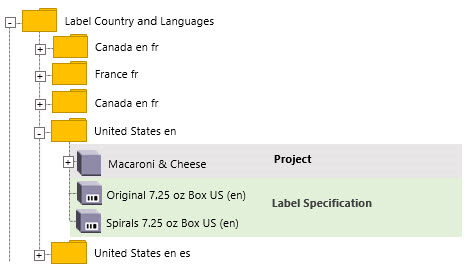
|
Object Type Name |
Object Type ID |
Purpose |
|---|---|---|
|
Label Country and Languages Root |
PLMLabelCountryAndLanguagesRoot |
Root level for storing the language bundle library. |
|
Label Country and Languages |
PLMLabelCountryAndLanguages |
An object that will hold attributes containing country code and language code for a label variation. Recommended classification names to represent country name plus language code(s). |
PLM Digital Asset
The PLM digital asset hierarchy organizes product lifecycle digital images uploaded or inserted by the customer. Food images will be located at:
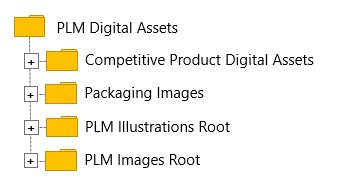
|
Object Type Name |
Object Type ID |
Purpose |
|---|---|---|
|
Digital Assets Root |
PLMDigitalAssetsRoot |
A top-level organization level for digital assets. |
|
Competitive Product Digital Assets |
PLMCompetitiveProductDigitalAssetsRoot |
A top-level organization level for competitive digital assets. |
|
Packaging Images |
PLMPackagingImagesRoot |
A top-level organization level for packaging digital assets. |
|
PLM Illustrations Root |
PLMIllustrationsRoot |
A top-level organization level for PLM illustration digital assets. |
|
PLM Images Root |
PLMImagesRoot |
A top-level organization level for PLM digital assets. |
PLM Product Classification
The PLM product classification hierarchy organizes products based on GS1’s Global Product Classification. The lowest level is used to organize projects, requirements, and parameters. This allows specific values of parameters and requirements to vary by the type of product being produced.
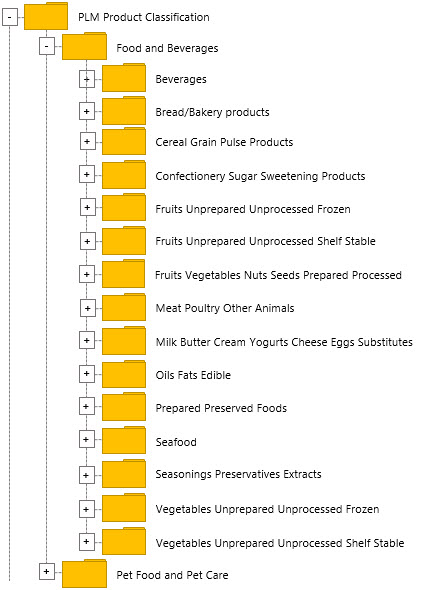
|
Object Type Name |
Object Type ID |
Purpose |
|---|---|---|
|
PLM Product Classifications |
PLMProductClassificationsRoot |
An organization level for products based on GS1’s Global Product Classification. |
|
PLM Product Segment |
PLMProductSegment |
An organization level for products. |
|
PLM Product Family |
PLMProductFamily |
An organization level for products. |
|
PLM Product Class |
PLMProductClass |
An organization level for products. |
|
PLM Product Group |
PLMProductGroup |
An organization level for Design Specifications, Requirements, and Parameters. Allows specific values of Requirements and Parameters to vary by the type of product being produced. |